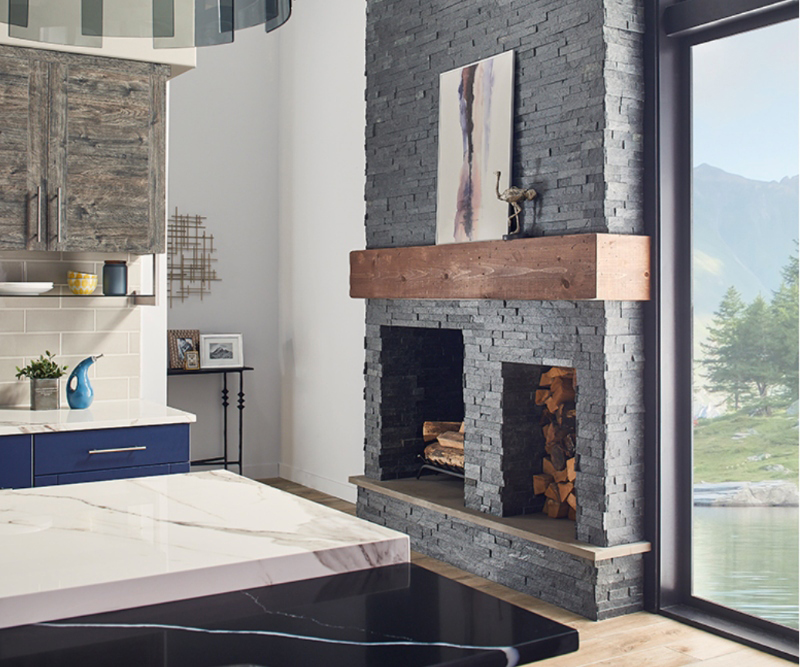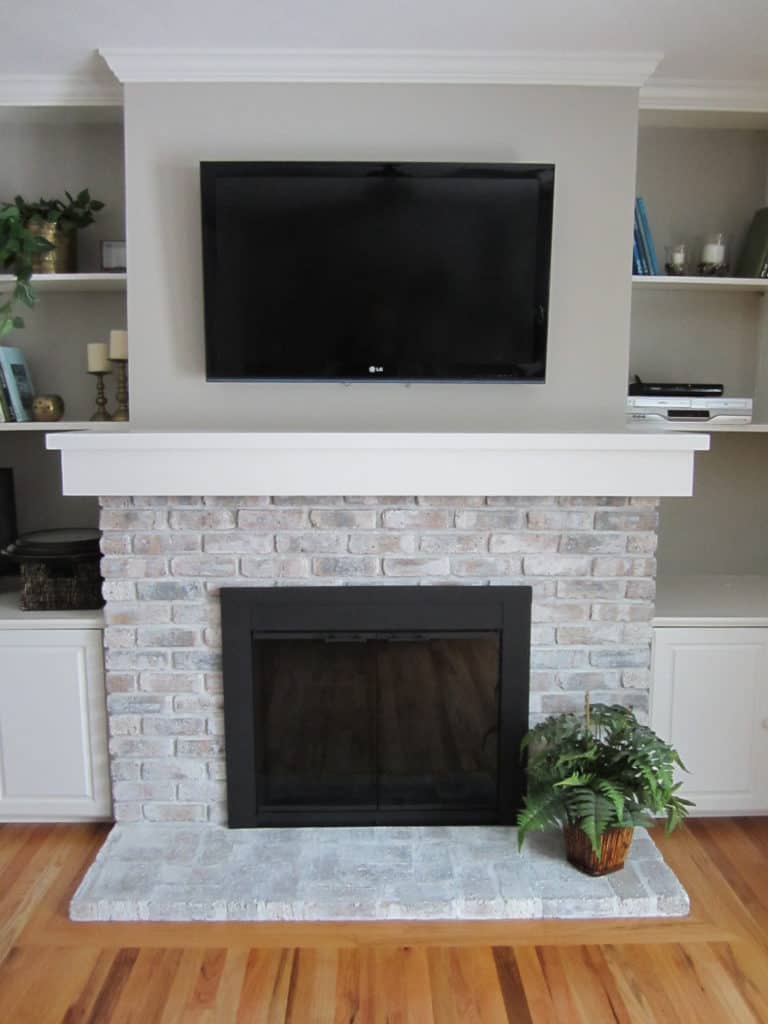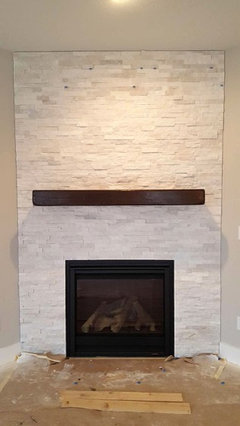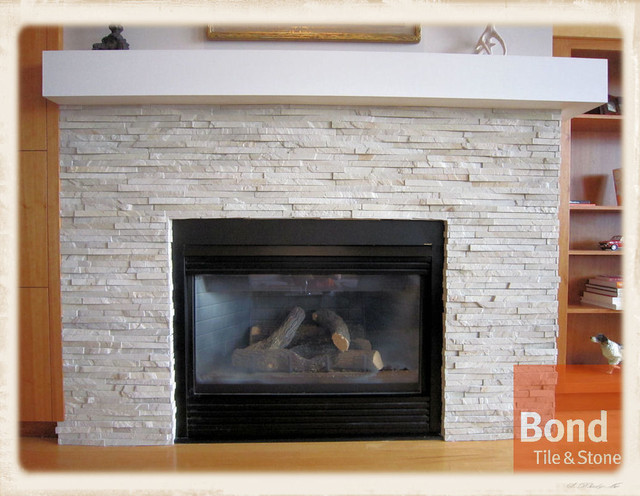A sandstone tile fireplace brings natural warmth and texture to any living space, creating a stunning focal point with earthy appeal. Unlike uniform manufactured materials, each sandstone tile has unique variations in color and pattern that add organic character to your fireplace surround. This versatile stone works with numerous design styles, from rustic cabins to contemporary lofts. Let’s find out why sandstone makes an excellent fireplace material, the different types available, design possibilities, installation requirements, maintenance needs, and how to choose the perfect sandstone tiles for your home.
Why Choose Sandstone for Your Fireplace
Sandstone offers exceptional durability for fireplace applications, standing up well to heat exposure without cracking or discoloration. Its natural thermal properties make it safer than many synthetic materials, as it absorbs and radiates heat gradually. The stone’s textured surface hides minor imperfections and soot marks better than smooth finishes, maintaining its attractive appearance with minimal upkeep. Unlike some stones that feel cold and formal, sandstone’s earthy tones create an inviting, cozy atmosphere perfect for gathering around the fire.
From a design perspective, sandstone provides incredible versatility. The natural color variations within each tile mean no two fireplace surrounds will look exactly alike. Ranging from soft beiges and creams to rich golds and rust tones, sandstone complements both light and dark color schemes. Its organic texture pairs beautifully with wood mantels, metal accents, or other natural materials. Whether you want a subtle backdrop or a dramatic statement piece, sandstone can be cut and arranged to achieve your desired look.
Cost-wise, sandstone offers an attractive middle ground between premium natural stones and basic manufactured options. While prices vary by quality and source, it’s generally more affordable than marble or granite while offering similar longevity. The material’s workability also keeps installation costs reasonable compared to harder stones that require specialized cutting. For homeowners wanting natural stone without the premium price tag, sandstone delivers excellent value.
Types of Sandstone for Fireplaces
Quarried sandstone comes in several distinct categories, each with unique characteristics. Freestanding sandstone features the most dramatic color variations and natural cleft surfaces, perfect for creating a rugged, organic look. This type often shows visible fossil impressions and mineral deposits that add geological interest to your fireplace surround. The irregular edges and textured face make it ideal for rustic or cottage-style interiors.
Sawn sandstone provides a more uniform appearance with smooth, squared edges suitable for contemporary designs. The cutting process reveals the stone’s internal patterning while creating clean lines that work well in modern spaces. Honed sandstone takes this a step further with a matte, velvety surface that softens the stone’s appearance. These processed options allow for tighter grout lines and more precise installations than rough-cut varieties.
Coloration varies significantly by region, with Indian sandstone offering warm gold and amber tones, while American varieties often show cooler beige and gray hues. Some sandstones contain iron oxide deposits that create dramatic rust-colored veining. When selecting tiles, examine multiple pieces to understand the full color range, as individual tiles may look quite different from showroom samples. Consider how the stone’s natural variations will work across your entire fireplace surround.

Design Possibilities with Sandstone Tiles
Sandstone’s versatility allows for numerous design approaches. A full floor-to-ceiling surround makes a dramatic statement, especially with stacked stone or ashlar patterns. For a subtler look, use sandstone just around the firebox opening paired with painted drywall or wood paneling above. Mixing sandstone with other materials like slate or brick creates interesting textural contrasts. Consider incorporating sandstone into the hearth as well for a cohesive appearance.
The tile size and pattern significantly impact the overall aesthetic. Large-format sandstone tiles create a clean, modern look with minimal grout lines. Mosaic sheets composed of small sandstone pieces work well for curved surfaces or intricate designs. Herringbone, chevron, and basketweave patterns add movement to the installation, while random stacked layouts enhance the natural, organic feel. Bookmatched tiles, where consecutive slabs are mirrored, create striking symmetrical patterns in the stone’s natural veining.
Edge treatments offer additional design flexibility. Rough, natural edges emphasize the stone’s earthy qualities, while polished or chamfered edges lend refinement. Mixing different finishes within the same installation – perhaps honed tiles around the firebox with textured tiles above – adds depth without overwhelming the space. Consider how the sandstone will interact with your mantel choice, whether it’s a rustic wood beam or sleek metal shelf.
Installing a Sandstone Tile Fireplace
Proper installation begins with surface preparation. The fireplace surround must be structurally sound, clean, and flat before tiling begins. For masonry fireplaces, repair any cracks or crumbling mortar. On wood-framed walls, install cement backer board to provide a stable, fire-resistant base. Always check local building codes for clearance requirements between the firebox and combustible materials.
Sandstone tiles require specific setting materials for best results. Use a high-quality polymer-modified thinset mortar designed for natural stone. The mortar should be mixed to a creamy consistency that holds the tile securely without oozing through joints. For the grout, choose a color that complements the sandstone – earth tones typically work better than bright whites. Sandstone’s porosity means it may need sealing before grouting to prevent staining.
Layout planning prevents awkward cuts and ensures balanced patterns. Dry-lay tiles first to visualize the arrangement, keeping in mind that the focal areas around the firebox should showcase the most attractive pieces. Use tile spacers to maintain consistent grout lines, adjusting as needed for irregularly shaped tiles. Cut sandstone with a wet saw equipped with a diamond blade, working slowly to prevent chipping. Allow proper curing time before exposing the installation to heat.
Maintaining Your Sandstone Fireplace
Regular maintenance keeps sandstone looking its best. Dust the surface weekly with a soft brush or dry cloth to prevent buildup in the textured surface. For deeper cleaning, use a pH-neutral stone cleaner and warm water, scrubbing gently with a soft-bristle brush. Avoid acidic cleaners like vinegar or lemon juice that can etch the stone’s surface over time. Immediately wipe up any soot or ash spills to prevent staining.
Sealing protects sandstone from stains and makes cleaning easier. Penetrating sealers designed for natural stone should be applied annually, or more often in high-use areas. Test the sealer on a small inconspicuous area first to ensure it doesn’t darken the stone undesirably. Reapply until the stone no longer absorbs the product, then wipe off any excess. Quality sealers won’t change the stone’s appearance but will cause water to bead on the surface.
Address repairs promptly to prevent worsening damage. Minor chips can be filled with color-matched epoxy resin or stone filler. For cracked tiles, replacement is often better than repair to maintain structural integrity. Keep extra tiles from the original installation for this purpose, as matching sandstone’s natural variations later can be challenging. Protect the hearth from heavy impacts that could crack tiles, using a decorative screen if needed.
Choosing the Right Sandstone Tiles
Select sandstone tiles based on both aesthetic preferences and practical considerations. Examine multiple tiles from the same lot to understand the color and texture range. Thicker tiles (at least 3/4″) withstand heat fluctuations better than thin veneers. For high-traffic areas, choose denser sandstone varieties that resist scratching and wear. The tiles should feel substantial and uniform in thickness, without visible cracks or weak spots.
Consider how the stone’s color will work with your existing decor. Lighter sandstones make small rooms feel more spacious, while darker varieties create cozy, intimate atmospheres. Request large samples to view in your actual space at different times of day, as lighting dramatically affects sandstone’s appearance. Look for tiles with consistent quality across the batch, avoiding those with excessive soft spots or crumbling edges.
Finally, think about long-term maintenance when making your selection. Highly textured tiles show less wear but collect more dust than smooth finishes. Darker sandstone hides soot better than light colors. If low maintenance is a priority, choose tiles that have been pre-sealed at the factory. Investing in quality sandstone from reputable suppliers ensures you’ll enjoy your fireplace surround for decades.
How heat-resistant is sandstone for fireplace use?
Sandstone is naturally heat-resistant and makes an excellent fireplace material. It absorbs and radiates heat gradually without cracking under normal fireplace temperatures. However, direct flames shouldn’t touch the stone surface continuously. Always maintain proper clearance between the firebox and surround as specified by local building codes. Thicker sandstone tiles handle heat better than thin veneers. While sandstone won’t burn, dramatic temperature changes can potentially cause cracking over many years of use.
Can sandstone tiles be used for the fireplace hearth?
Yes, sandstone works well for hearths when properly installed. Choose dense, durable tiles at least 3/4″ thick for this high-traffic area. The hearth should extend at least 16″ in front of the firebox and 8″ on each side for safety. Use a heat-resistant mortar and ensure the substrate is perfectly level. Consider slightly textured sandstone for hearths to prevent slipping, and seal it thoroughly to resist ash and soot stains. Always check local codes for specific hearth requirements.
How do I clean soot stains from sandstone?
For fresh soot, first vacuum loose particles with a soft brush attachment. Make a paste from baking soda and water, apply to stained areas, and let sit for 15 minutes before gently scrubbing with a soft brush. Rinse thoroughly with clean water. For stubborn stains, use a poultice made from diatomaceous earth and hydrogen peroxide. Avoid abrasive cleaners that could scratch the stone’s surface. Always test cleaning methods in an inconspicuous area first. Regular sealing makes soot removal much easier.
Is sandstone fireplace surround difficult to install?
Sandstone installation requires more skill than standard ceramic tile but is manageable for experienced DIYers. The stone’s weight and irregularity make precise cutting and leveling crucial. You’ll need a wet saw with diamond blade, proper mortar, and stone sealant. Working with large-format tiles or intricate patterns often warrants professional installation. Proper surface preparation and following manufacturer instructions are essential. If unsure, consult a stone mason – improper installation can lead to cracking or safety issues.
How does sandstone compare to other natural stones for fireplaces?
Sandstone offers a warmer, more textured look than slate or granite, with better heat retention than marble. It’s typically more affordable than granite or marble while offering similar durability. Unlike polished stones, sandstone’s natural texture hides minor imperfections well. It’s softer than granite but easier to cut and shape during installation. Sandstone’s porous nature requires more frequent sealing than denser stones. For rustic or organic designs, sandstone often looks more authentic than uniform manufactured stone veneers.
Can I install sandstone tiles over my existing brick fireplace?
Yes, sandstone tiles can be installed over brick if the surface is sound and properly prepared. Clean the brick thoroughly and repair any loose mortar. Apply a scratch coat of mortar to create an even surface, then use thin-set mortar designed for natural stone. Consider the added thickness – your firebox opening may need adjustment. For best results, remove protruding bricks and grind down high spots first. In some cases, installing cement backer board over the brick provides a better substrate. Always ensure proper clearances are maintained after covering existing surfaces.
Stone, granite, slate or ceramic fireplace surround?
Vogue Peel & Stick Golden Honey Quartzite Stacked Stone
Fireplaces – Contemporary – Living Room
Ledgestone for outside Home fireplace, Stone veneer fireplace
Related Posts:










